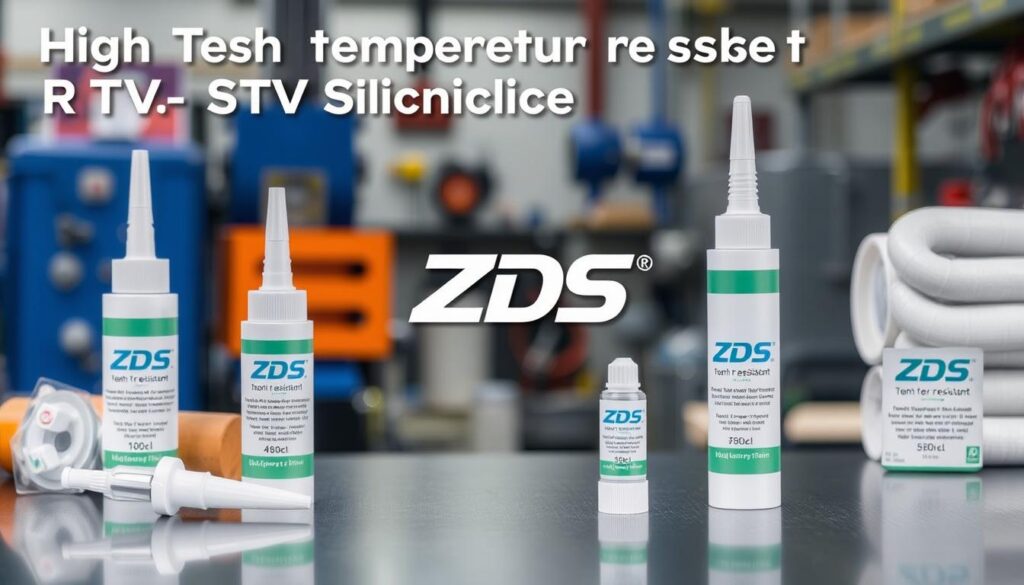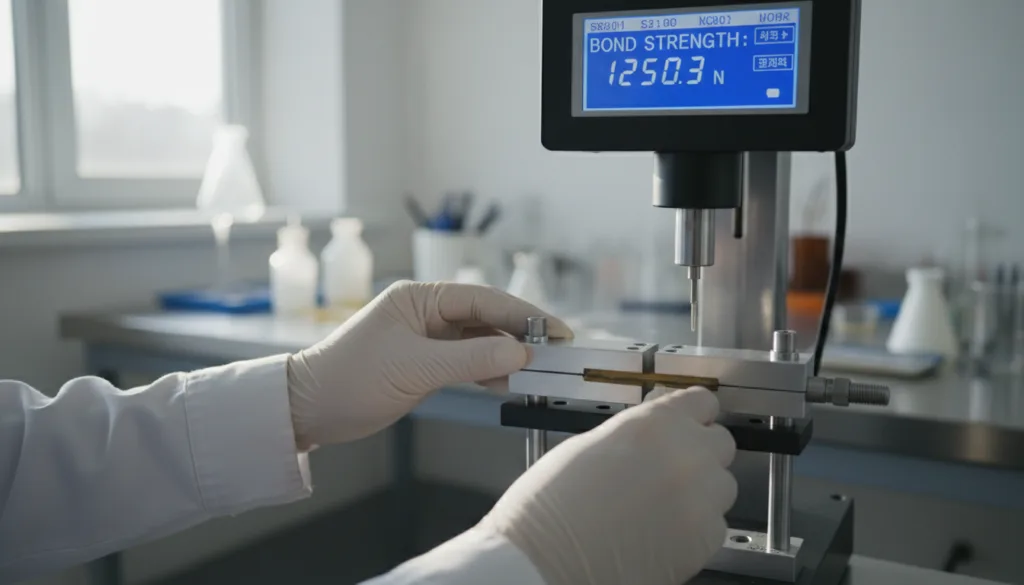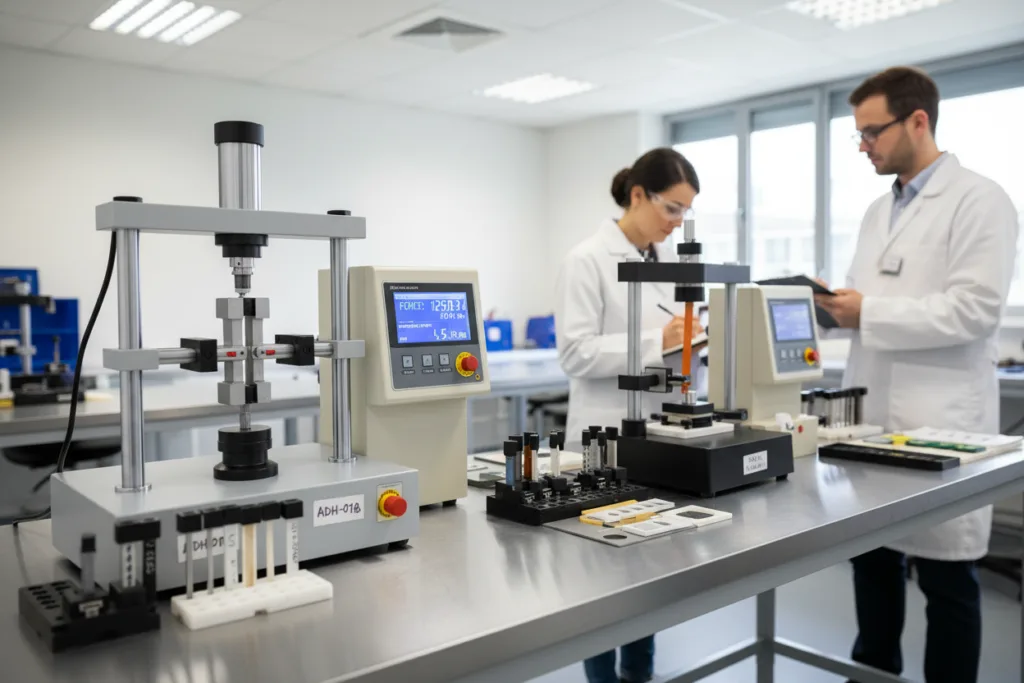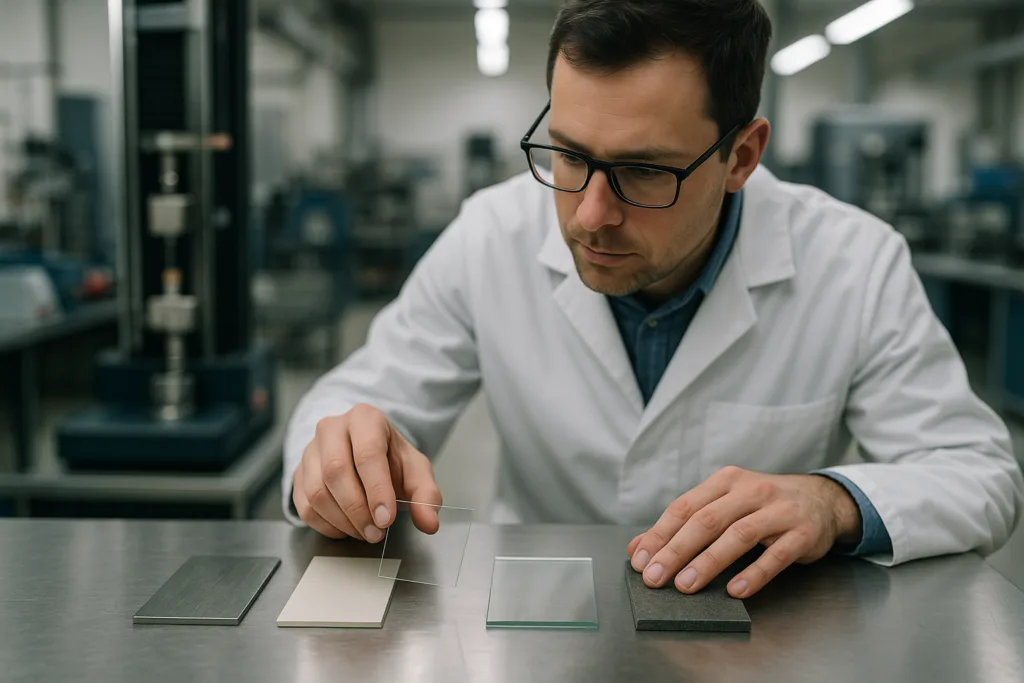In the world of industrial manufacturing, choosing the right adhesive is key. RTV silicone adhesives stand out for their top-notch performance and flexibility. They are essential for industrial-grade silicone sealants needed in tough environments and demanding tasks.
RTV silicone adhesives are known for their high-temperature resistant bonding. They are a top pick for many industrial fields. This includes automotive, electronics, construction, and HVAC, where they keep critical parts safe and sound.
This guide will help you pick the best RTV silicone adhesive for your needs. By learning about their special properties and how they perform, you can make smart choices. This will help your projects last longer and work better.
Key Takeaways
- RTV silicone adhesives offer superior high-temperature resistance, making them ideal for industrial applications.
- These adhesives provide long-lasting flexibility and excellent chemical resistance, ensuring the durability of bonded components.
- Selecting the right RTV silicone adhesive requires careful consideration of application requirements, temperature and chemical compatibility, and curing time.
- Proper surface preparation, application techniques, and curing processes are critical for the best adhesion and performance.
- RTV silicone adhesives are widely used in the automotive, electronics, and construction industries, among others, due to their versatility and reliability.
Understanding RTV Silicone Adhesives
RTV (Room Temperature Vulcanizing) silicone adhesives are a top pick for tough industrial jobs. They are flexible and reliable, making them perfect for many industrial needs.
What is RTV Silicone?
RTV silicone is a special kind of silicone that hardens at room temperature. It doesn’t need high heat or special tools to cure. This makes it great for creating strong, weather-resistant bonds.
Key Properties of RTV Silicone
- Exceptional temperature resistance, able to withstand temperatures from -60°F to 400°F (-51°C to 204°C)
- Excellent flexibility and elongation, providing a durable and long-lasting bond
- Outstanding chemical resistance, making them suitable for a wide range of industrial applications
- Versatile silicone caulks that can adhere to a variety of substrates, including metals, plastics, and glass
Applications in Industrial Settings
RTV silicone adhesives are great for many industrial uses. They are perfect for:
- Sealing and bonding in automotive manufacturing
- Insulating and protecting electrical components
- Weather-resistant sealants for construction and HVAC systems
- Bonding and assembling industrial machinery and equipment
Knowing about RTV silicone helps professionals make strong, lasting bonds. They can meet the needs of their specific jobs.
Benefits of Using RTV Silicone Adhesives
RTV (Room Temperature Vulcanizing) silicone adhesives are great for industrial use. They stand out for their high temperature resistance, lasting flexibility, and strong chemical resistance. These qualities are key in many industrial settings.
Superior Temperature Resistance
RTV silicone adhesives can handle high temperatures well. They keep their shape and stickiness even in extreme heat. This makes them perfect for flexible adhesive gaskets, vibration-dampening compounds, and more in tough thermal conditions.
Long-lasting Flexibility
RTV silicone adhesives are very flexible. These chemical-resistant silicone adhesives stay flexible for a long time. They can handle movement, stress, and vibration without losing their bond. This is important for places where the adhesive needs to stay strong despite changes.
Excellent Chemical Resistance
RTV silicone adhesives resist many chemicals well. They can handle solvents, oils, and corrosive stuff. This makes them great for places where harsh chemicals or cleaners might be used. Their chemical strength helps keep the bond strong, even in tough spots.
Using RTV silicone adhesives can improve performance and product life in industry. They’re good for sealing, bonding, or dampening. These adhesives provide a flexible solution for the varied needs of today’s industrial world.
Top RTV Silicone Adhesives for Industrial Use
In heavy-duty industrial settings, the best RTV silicone adhesives shine. They handle extreme temperatures, resist harsh chemicals, and stay flexible for a long time. This makes them perfect for many manufacturing and maintenance tasks. Here are some top RTV silicone adhesives for industrial use:
Product A Overview
Product A is made for tough industrial spots. It’s a heavy-duty RTV silicone sealant with great adhesion and durability. It works well with metal, glass, and plastics, making it great for the automotive, HVAC, and electronics fields.
Product B Overview
Product B is a top-notch RTV silicone adhesive. It’s known for its strong chemical resistance and flexibility. It’s perfect for places that need to fight off oils, fuels, and other tough chemicals, like in manufacturing and aerospace.
Product C Overview
Product C is a reliable and easy-to-use RTV silicone adhesive. It sticks well to many materials, including metals, plastics, and rubber. It’s a good choice for construction, HVAC, and transportation needs.
Each of these premium RTV silicone adhesives has special benefits for industrial users. By looking at what your application needs, you can pick the best RTV silicone adhesive for top performance and durability.
“These RTV silicone adhesives are truly the best in the industry, providing unparalleled performance and reliability for our most demanding industrial applications.”
| Product | Key Features | Ideal Applications |
|---|---|---|
| Product A |
|
|
| Product B |
|
|
| Product C |
|
|
How to Choose the Right RTV Silicone Adhesive
Finding the right industrial-grade silicone sealant or high-temperature adhesive can be tough. But, by looking at a few important factors, you can pick the best RTV silicone for your needs. Let’s look at what you need to consider when choosing the right RTV silicone adhesive.
Consider Application Requirements
First, think about what your application needs. Look at the temperature range, chemical exposure, and the materials you’ll be bonding. This helps you find an adhesive that can handle your industrial environment’s challenges.
Analyzing Temperature and Chemical Compatibility
RTV silicone adhesives are great at handling high temperatures and many chemicals. Make sure to check the manufacturer’s specs. This ensures the adhesive can handle your application’s temperatures and chemicals, preventing early failure and ensuring durability.
Evaluating Cure Time and Handling
The curing time and how easy it is to apply also matter. Think about the cure time, whether it’s one-part or two-part, and how simple it is to use. The right adhesive can make your assembly process smoother and reduce downtime.
| Feature | Importance | Examples |
|---|---|---|
| Temperature Range | Critical for high-heat applications | -40°F to 400°F (-40°C to 204°C) |
| Chemical Resistance | Vital for exposure to solvents, oils, and other chemicals | Resistant to fuels, oils, and dilute acids/bases |
| Cure Time | Impacts production efficiency and process | Rapid cure in 10-30 minutes, or slower cure for larger parts |
By carefully considering these factors, you can confidently choose the right industrial-grade silicone sealants or high-temperature adhesives. They will give you the best performance and durability for your specific needs.
Application Techniques for RTV Silicone
When using versatile silicone caulks, weather-resistant sealants, and flexible adhesive gaskets, proper application is key. Let’s look at the essential steps for a successful application and top performance.
Surface Preparation
Starting with a clean surface is vital for RTV silicone application. Clean the surface well to remove dirt, oil, or debris that could affect adhesion. If needed, roughen the surface to improve bonding strength.
Applying the Adhesive
When applying RTV silicone, follow the manufacturer’s guidelines carefully. Spread the adhesive in a continuous bead or pattern for even coverage. Make sure to apply it in a well-ventilated area and wear the right PPE for safety.
Curing Process and Timeframes
The curing process is critical for RTV silicone adhesives. Let the adhesive cure fully, as recommended by the manufacturer, before applying any stress or pressure. This ensures strong adhesion, flexibility, and long-term performance of the sealants and gaskets.
By following these best practices, you can achieve a strong, durable bond with your versatile silicone caulks and RTV silicone products. Proper application techniques are essential to get the most out of these high-performance materials.
Common Industrial Applications of RTV Silicone
RTV (Room Temperature Vulcanizing) silicone adhesives are very versatile. They are used in many industrial sectors. These adhesives are key in vibration-dampening, chemical-resistant sealing, and more.
Automotive Industry
In cars, RTV silicone adhesives keep things running smoothly. They bond and seal parts, reducing vibration. RTV silicones are also in engine gaskets and weatherstripping, where they need to be flexible and seal well.
Electronics and Electrical Components
The electronics and electrical fields use RTV silicone adhesives a lot. They protect sensitive parts from the environment. RTV silicones seal electronic circuits and act as potting compounds, insulating and absorbing shocks.
Construction and HVAC
In construction and HVAC, RTV silicone sealers are vital. They resist chemicals and extreme temperatures. This makes them perfect for sealing and bonding in buildings and HVAC systems.
RTV silicone adhesives are used in many ways. They help in car making, construction, and HVAC. Their strength, flexibility, and quality make them a top choice for professionals.
Safety Considerations When Using RTV Silicone
When working with Best RTV Silicone Adhesive for Industrial Applications and other industrial-grade silicone sealants, safety is key. These strong adhesives need special care to keep you safe and the work area safe too.
Personal Protective Equipment (PPE) Needs
When using RTV silicone adhesives, you need the right gear. This includes:
- Gloves: Chemical-resistant gloves protect your hands from the adhesive.
- Eye protection: Safety glasses or goggles keep your eyes safe from fumes or splashes.
- Respiratory protection: A respirator or good air flow helps avoid harmful vapors.
Ventilation and Fumes
Using industrial-grade silicone sealants can release harmful fumes. Make sure the area is well-ventilated. This can be through natural air flow or machines.
Storage and Disposal
Storing and disposing of RTV silicone adhesives safely is important. Keep them in a cool, dry spot, away from sunlight and heat. Dispose of unused or expired adhesives as per local rules.
By following these safety tips, you can use Best RTV Silicone Adhesive for Industrial Applications and other industrial-grade silicone sealants safely. This protects you and the environment.
Comparing RTV Silicone with Other Adhesives
Understanding the strengths and weaknesses of different adhesives is key in industrial settings. Let’s see how high-temperature resistant adhesives like RTV silicone stack up against polyurethane, epoxy, and acrylic adhesives.
RTV Silicone vs. Polyurethane Adhesives
RTV silicone adhesives beat polyurethane in temperature resistance and flexibility. They’re perfect for extreme temperatures or long-lasting durable bonding solutions. Polyurethane might be cheaper and offer a stronger initial bond for some projects.
RTV Silicone vs. Epoxy Adhesives
Epoxy adhesives create very strong, rigid bonds, great for structural needs. But RTV silicone is more flexible and better for bonding materials with different expansion rates. It also has better chemical resistance than epoxy in many cases.
RTV Silicone vs. Acrylic Adhesives
Acrylic adhesives cure quickly and bond many materials, including plastics. But RTV silicone is better for versatile silicone caulks and resisting weathering, UV, and high temperatures. It stays flexible longer than acrylic.
The right choice between RTV silicone and other adhesives depends on your project’s needs. Consider the materials, environment, and desired performance. This careful thought ensures you pick the best adhesive for your project.
Innovations in RTV Silicone Technology
The world of adhesives and sealants is always changing. RTV (Room Temperature Vulcanizing) silicone adhesives are no exception. They’re getting better at keeping things running smoothly and sustainably.
Advances in Adhesive Formulations
Recently, RTV silicone adhesives have seen big improvements. Scientists have created new mixes that are better at sealing and sticking. These new formulas are more flexible and last longer, even in tough conditions.
Eco-Friendly RTV Silicone Options
More people care about the environment, and so do manufacturers. They’ve made eco-friendly RTV silicones. These adhesives use safe ingredients and fewer harmful chemicals. They’re great for industries that want to be green.
High-Performance RTV Silicones
For the toughest jobs, there are special RTV silicones. They can handle extreme heat, vibrations, and chemicals. These adhesives are perfect for aerospace, cars, electronics, and more.
| Feature | Benefit |
|---|---|
| Weather-resistant sealants | Exceptional durability in outdoor and harsh environments |
| Flexible adhesive gaskets | Accommodate movement and vibration without compromising the bond |
| Vibration-dampening compounds | Reduce the impact of mechanical stress on critical components |
RTV silicone technology is key to improving many products and systems. It helps them work better, last longer, and be kinder to the planet. By using these new technologies, companies can meet their customers’ needs and stay ahead.
Troubleshooting Common RTV Silicone Issues
Working with chemical-resistant silicone adhesives or heavy-duty silicone sealers in industrial settings can have its challenges. Knowing how to fix common problems is key. As the Best RTV Silicone Adhesive for Industrial Applications, we’ve put together a guide to help you solve these issues and get the best results.
Tackiness and Incomplete Curing
When the adhesive doesn’t cure fully, it can feel sticky. This might happen if the surfaces aren’t clean enough, if not enough adhesive is used, or because of the environment. To fix this, make sure the surfaces are clean and dry before applying the adhesive. Also, follow the cure time and temperature as suggested by the manufacturer.
Adhesion Failures
Adhesion failures happen when the adhesive doesn’t stick well to the surface. This could be because the materials don’t match, the surface is dirty, or it wasn’t prepared right. To avoid this, pick a silicone adhesive that fits your needs. Clean and prime the surface well to get a strong bond.
Environmental Factors Affecting Performance
Things like temperature, humidity, and chemicals can affect how well RTV silicone adhesives work. To keep the bond strong, think about the conditions it will face. Choose a silicone adhesive that can handle the expected environmental challenges.
By tackling these common problems and using best practices, you can make sure your industrial projects last a long time and work well.
Maintenance and Care of RTV Silicone Bonded Products
Keeping products bonded with industrial-grade silicone sealants or high-temperature resistant adhesives in good shape is key. This includes cleaning, checking for damage, and fixing any issues. Let’s look at the best ways to keep your durable bonding solutions in great condition.
Cleaning Procedures
It’s important to clean the surfaces where RTV silicone adhesives are used regularly. Use a mild, non-abrasive cleaner and a soft cloth or sponge. This helps remove dirt, grime, or residue without harming the silicone bond.
Avoid harsh chemicals or solvents, as they can damage the silicone. Rinse the area well with clean water. Let it dry completely before checking or reapplying any adhesive.
Inspection and Repair Guidelines
- Regularly check all silicone-bonded areas for cracks, peeling, or separation.
- If you find minor damage, use a high-quality RTV silicone sealant to fix it. This ensures a strong seal and bond.
- For bigger damage or failures, you might need to remove the old silicone and apply a new layer. Follow the manufacturer’s instructions carefully.
- Make sure the surface is ready and the new silicone matches the existing materials for the best adhesion.
By following these simple care and maintenance tips, you can make your industrial-grade silicone sealants and high-temperature resistant adhesives last longer. This keeps them reliable and effective in your projects.
| Maintenance Task | Frequency | Importance |
|---|---|---|
| Surface Cleaning | Quarterly | High |
| Inspection | Monthly | High |
| Minor Repairs | As Needed | Medium |
| Major Reapplication | As Needed | High |
Conclusion: Selecting the Best RTV Silicone for Your Needs
RTV silicone adhesives are great for many industrial uses. They can handle high temperatures and stay flexible for a long time. They also resist chemicals well, making them perfect for tough environments.
Summary of Key Points
We’ve talked about RTV silicone adhesives and their benefits. We’ve also looked at the best products available. Choosing the right RTV silicone depends on several factors like temperature and chemical resistance.
It’s also important to think about how long it takes to cure and how it handles. We’ve covered how to apply them and their uses in industry. Plus, we’ve talked about safety when using these flexible gaskets.
Final Recommendations
When picking the best RTV silicone, talk to the maker or an expert. This ensures you get the right product for your needs. Think about what you need in terms of performance and durability.
By doing this, you can trust that your choice will last and work well. RTV silicone adhesives are known for their reliability and long-lasting quality.
FAQ
What is RTV Silicone and how is it used in industrial applications?
RTV (Room Temperature Vulcanizing) silicone is a strong adhesive and sealant. It can handle high temperatures and harsh chemicals. It’s used for durable bonding and sealing in industries.
What are the key properties that make RTV silicone adhesives suitable for industrial use?
RTV silicone adhesives resist high temperatures and chemicals well. They are flexible and last long. This makes them perfect for tough industrial jobs.
How do I choose the right RTV silicone adhesive for my specific industrial needs?
Look at the application’s needs, like temperature and chemical exposure. Also, check if the adhesive works with your materials and cures right. This helps pick the best one for your job.
What are the common industrial applications for RTV silicone adhesives?
RTV silicone is used in cars, electronics, construction, and HVAC. It bonds, seals, and dampens vibrations in these areas.
What safety precautions should I take when using RTV silicone adhesives in an industrial environment?
Wear proper PPE, ensure good air flow, and follow storage and disposal rules. This keeps you safe from fumes and skin contact risks.
How do RTV silicone adhesives compare to other industrial adhesive options like polyurethane, epoxy, and acrylic?
RTV silicone stands out for its heat, flexibility, and chemical resistance. The right choice depends on your application’s needs and desired results.
What are some of the latest innovations in RTV silicone technology for industrial applications?
New RTV silicone tech includes eco-friendly options and high-performance adhesives. There are also products with better adhesion and durability.
How can I troubleshoot common issues with RTV silicone adhesives in industrial settings?
Tackiness, incomplete curing, and adhesion failures can be fixed with proper prep and application. Environmental factors also play a role. Talking to adhesive makers can help solve these problems.










